Iowa House and Senate Republicans have agreed to increase the allocation for Governor Kim Reynolds’ office by more than 20 percent, even as many state agencies are receiving status quo budgets for fiscal year 2024, which begins on July 1.
Senate Appropriations Committee chair Tim Kraayenbrink acknowledged during floor debate on April 26 that Republicans do not know how the governor’s office plans to use an additional $500,000 standing appropriation for FY2024.
It was an extraordinary moment, but not a surprising one. For years, Reynolds’ staff have avoided disclosing how the governor’s office was covering expenses that greatly exceeded the funds allocated by the legislature, by nearly $900,000 in fiscal year 2020 and roughly the same amount in fiscal year 2021.
The Reynolds administration has also made it increasingly difficult to uncover details about the governor’s office spending through open records requests. Budget reports for fiscal year 2022, which ran from July 2021 through last June, were provided in a different format from previous years, concealing how much other state agencies provided to compensate Reynolds’ staffers. In response to a records request, the governor’s office claimed to have no invoices for such payments.
Nevertheless, documents obtained by Bleeding Heartland indicate that other state agencies contributed about $670,000 to cover salaries and benefits for Reynolds’ staffers during fiscal year 2022. The governor’s office was able to cover another $115,000 in expenses by continuing to understaff the Office of State-Federal Relations, for which other state agencies are charged a fixed fee.
In other words, even an additional $500,000 appropriation, bringing the governor’s office general fund budget to $2.8 million for the coming fiscal year, probably would not be enough to cover all expenses.
“A BETTER WAY TO OPERATE”
Reynolds’ chief of staff Taryn Frideres made her case for the request during a February 20 meeting of the House Administration and Regulation Budget Subcommittee. She began by asserting the governor’s office budget has been “fairly stagnant for the last ten years.” This graphic was distributed to members of the subcommittee:
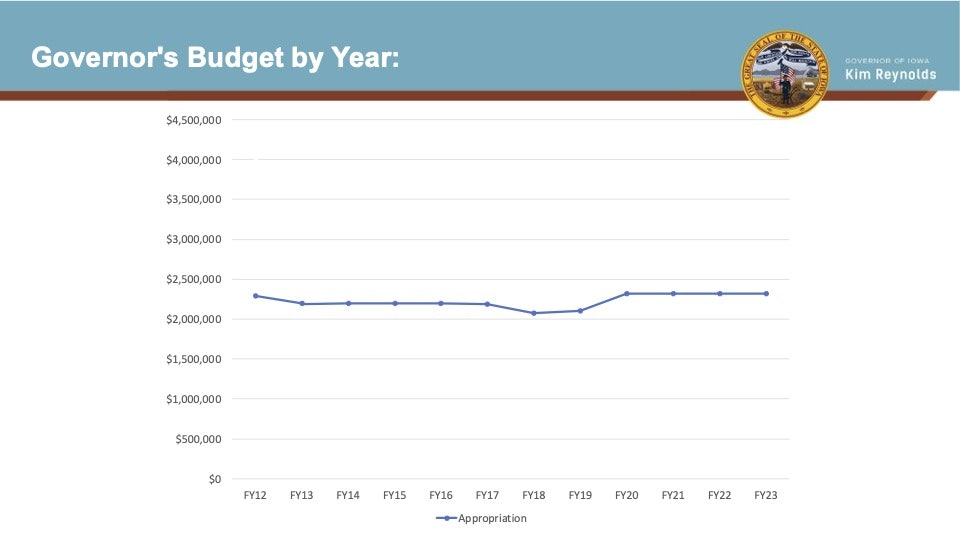
The bump for fiscal year 2020 reflects an additional $200,000 appropriation (a roughly 9 percent increase), which Republican lawmakers approved in 2019.
Frideres also claimed Iowa’s governor’s office is smaller than that of similarly-sized states. But the general fund appropriation of about $2.3 million is far below what Reynolds’ office actually spends: more than $3 million during each of the last several years.
Frideres acknowledged the governor’s office “has to utilize mechanisms such as MOUs and assessments to account for our actual expenditures.” She said the practice has been going on for decades and gives the governor’s staff less flexibility. Personnel costs account for roughly 95 percent of the office expenses.
“Public service is a privilege, and we have no intention of attempting to compete dollar for dollar with private sector wages,” Frideres told the subcommittee. But she said the office “has worked to hire more senior, experienced personnel.” The request of $2.8 million for next year would support that approach and “provide greater flexibility to leverage our staff” to oversee projects across state government, she said.
Under questioning from Democratic State Representative Megan Srinivas, Frideres said “the practical reality is that, like I said, our expenses—and every governor before us for the last two decades—exceed our appropriation.” She said “it’s a better way to operate” and “more transparent” to make sure “our actual appropriation is closer to our expenses, so that we can budget in a more straightforward way.”
After Frideres left the meeting room, I approached to ask whether the governor’s office would be able to fully cover its FY2024 budget with the additional $500,000 appropriation. Reynolds’ chief of staff did not make eye contact or acknowledge my question as she walked away. She ignored subsequent emails about the matter.
MAKING ENDS MEET
It’s true that the last four Iowa governors, including Democrats Tom Vilsack and Chet Culver, have used salary-sharing agreements, known as Memoranda of Understanding or MOUs. But the practice greatly expanded on Reynolds’ watch. For fiscal year 2021 (July 1, 2020 through June 30, 2021), eight state agencies covered $812,420.83 in salaries and benefits for nine employees in the governor’s office.
In addition, Reynolds has sometimes offloaded expenses not related to salaries to other agencies. During FY2021, the Office of Chief Information Officer paid for technology upgrades to a conference room in the governor’s suite, at a cost of $67,543.48. (Reynolds had initially approved the use of federal COVID-19 relief funds for that expense.)
Since 2017, assessments to other state agencies have produced $299,782 to support the Office of State-Federal Relations, “which historically has included two full time staff” in Washington, DC. But each year, Reynolds has left one position vacant in that office, allowing a large portion of the funding from those assessments to help balance the books for the governor’s office as a whole.
HALF A MILLION DOLLARS, “NO QUESTIONS ANSWERED”
Iowa Senate Republicans did not convene any subcommittee meetings for this area of the budget, despite requests from State Senator Claire Celsi, the ranking Democrat for the Administration and Regulation subcommittee.
So the first time Senate Democrats were able to raise questions about the proposed governor’s office budget was during floor debate on April 26, a few hours after Republicans published an amendment to Senate File 557 containing the additional $500,000. An eyebrow-raising exchange ensued between Kraayenbrink and State Senator Janet Petersen, the ranking Democrat on the Senate Appropriations Committee.
Kraayenbrink told Petersen, “I’m not sure” how the governor’s office would use the extra funds. He noted the legislature was not authorizing any additional FTE’s (full-time equivalent employees) in the proposed budget bill. “We asked the governor the same question, but I’m not positive what the answer was coming out of that.”
Petersen noted the recently enacted state government reorganization gave the governor authority to set unrestricted salaries for cabinet members. Might the $500,000 be used to give those officials raises or bonuses?
Kraayenbrink replied, “I’m pretty sure that that is not what this is for.”
Petersen: “OK, but you don’t know how the governor is using the extra five hundred thousand dollars?”
Kraayenbrink: “Exactly. Yes.”
Democratic State Senator Herman Quirmbach remarked a few minutes later that he found it “quite amazing” Reynolds asked for an additional $500,000 appropriation, and “and you give it to her, no questions asked. Well, maybe you asked some questions. It was no questions answered, I guess.”
Quirmbach speculated that since the proposed budget would not add any full-time equivalent employees, senators should conclude the governor’s staff will receive a half million dollars in raises. “What ever happened to the salary schedule?” he wondered.
Frideres told House members in February that the extra money would not be “a salary adjustment for our staff.” Senators would not have heard her comments, because Iowa Senate Republicans chose not to participate in joint budget subcommittee meetings that were a routine aspect of legislative work for decades.
I doubt the governor’s office will use the $500,000 primarily for raises. That amount of money probably wouldn’t fully cover the existing compensation packages for Reynolds’ staff.
I also suspect the governor’s office declined to outline a specific plan this time around because four years ago, Reynolds’ chief of staff Sara Craig Gongol misled lawmakers about how they would use the extra $200,000 appropriation. At that time, Republican floor managers in the House and Senate said they were told the governor’s office needed the funding to hire new analysts for health and tax policy. After making those hires, the governor’s office used other means to cover the cost of those employees’ salaries and benefits.
The Reynolds administration doesn’t make it easy to find out which funding streams pay for the governor’s personnel costs.
BUDGET REPORTS NO LONGER SHOW PAYMENTS VIA OTHER AGENCIES
Month-end reports comparing the budget to actual outlays have provided a useful window onto the governor’s office spending. For several years, Bleeding Heartland has requested those reports from the Iowa Department of Administrative Services (DAS).
Here is an example of the year-end report for fiscal year 2020. Entries in red show where outside funding sources supported salaries (“Personal Services”) or other costs in the governor’s office. That year’s budget was balanced thanks to $448,449 in federal COVID-19 relief funds, $294,700 from other agencies in keeping with MOUs, $63,952 from the Department of Administrative Services to pay part of Paul Trombino’s salary, and an $84,735 surplus from the Office of State-Federal Relations, because of the unfilled staff position.
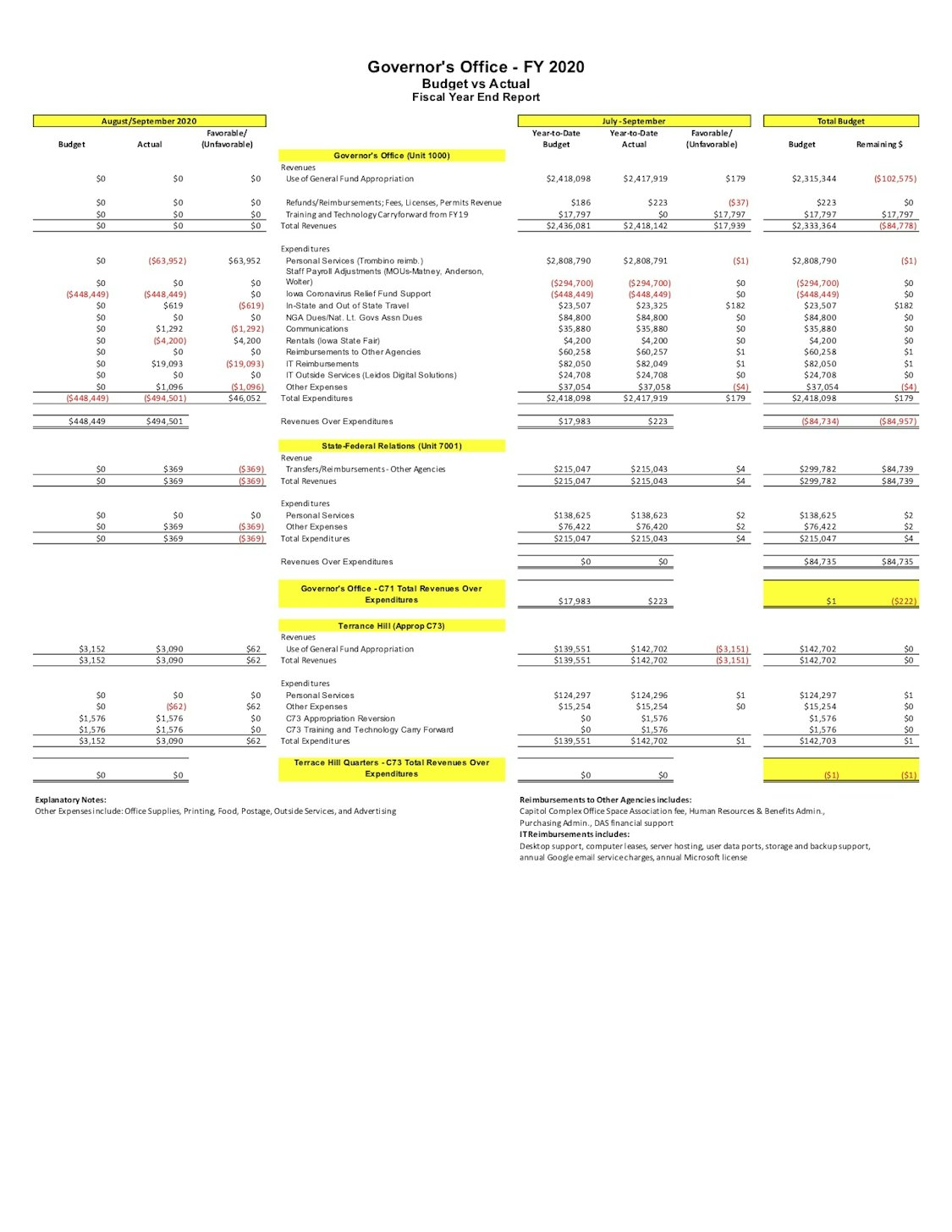
Worth noting: this budget report was one of the few official documents that showed Coronavirus Relief Fund money supporting the governor’s office. Reynolds’ staff orchestrated those $448,449 in CARES Act payments to run through the the Iowa Department of Homeland Security and Emergency Management before being allocated to cover part of the salaries for 21 members of the governor’s staff. Other state reports and databases showing how Iowa used COVID-19 relief funds listed that portion under Homeland Security, without revealing that federal money flowed on to the governor’s office.
State Auditor Rob Sand questioned the use of CARES Act funds for that purpose and later issued a report saying the governor should return the money used for her staff salaries to the Coronavirus Relief Fund. Reynolds has not done so.
In September 2022, as the books were about to close on the 2022 fiscal year, Bleeding Heartland requested the month-end budget reports from DAS. The agency finally provided a spreadsheet after the November 2022 election. But the format was unrecognizable and far less clear about money coming in and going out.
Tami Wiencek, the DAS public information officer, did not respond to messages seeking to clarify why the budget reports were so different. Nor did she acknowledge my requests to send FY2022 monthly reports in the format I had previously received.
I don’t think the formatting issue was related to any new accounting system, because the state never completed its planned switch to Workday for finances.
Since I can’t embed an .xls file into this post, I took pictures of pages from the spreadsheet DAS provided for FY2022. This page combined information from the main governor’s office, which had a general fund appropriation of $2,322,023, and the Office of State-Federal Relations, which received transfers from other agencies totaling $299,732. (A different page confirmed the Office of State-Federal Relations spent only $184,897 during the fiscal year, leaving a surplus of $114,835 that could be used to balance the overall budget for Reynolds’ office.)
Note how the monthly expenditures for “personal services” (salaries and benefits) fluctuate wildly.

Bleeding Heartland separately obtained salary records for employees on Reynolds’s staff, which show that most worked throughout FY2022. So this spreadsheet’s inconsistent “personal services” numbers would not be due to staffers working intermittently, taking months off at a time.
As far as I can tell, the figures reflect net outlays. Months with lower expenditures for personal services are those when other agencies were billed for some of the governor’s personnel costs. Wiencek didn’t explain the discrepancy.
This image of another tab from the FY2022 spreadsheet shows different levels of spending for personal services from month to month, just for the main governor’s office (that is, not including the Office of State-Federal Relations). Footnotes on this page indicate that some of the lines include “MOU reimbursements” from other agencies. But no dollar amounts are shown for such reimbursements.
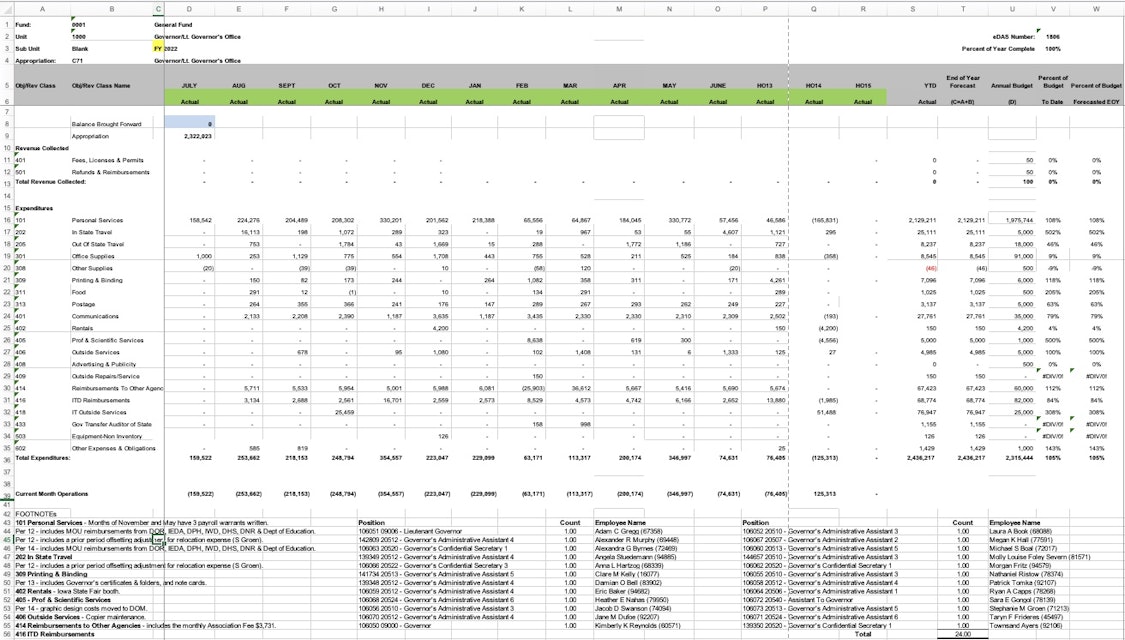
Adding to my doubts about the accuracy of this spreadsheet, the list of employees near the bottom of the page does not include some people who worked on Reynolds’ staff for part of FY2022, according to the salary records DAS provided (such as Pat Garrett, John Hirl, Joel Anderson, Paige Thorson, Traci Vitek, and Tracy Lindgren). Oddly, it does include a few people who joined the governor’s office after that fiscal year had ended (Laura Book, Jane Dufoe, and Angela Stuedemann began working on Reynolds’ staff during FY2023).
A footnote on the spreadsheet for FY2022 indicates that some graphic design costs were moved to the Department of Management, but doesn’t mention the size of that expenditure.
I searched for another way to nail down how much Reynolds’ office actually spent from July 2021 through June 2022.
A LONG WAIT FOR RELEVANT RECORDS
I have sometimes been able to obtain records related to governor’s office spending from the Iowa Department of Management, which monitors implementation of the state budget. So in September 2022, I asked DOM for copies of the FY2022 salary-sharing agreements as well as “Records showing all transfers of funds from any state agency or department to the Office of the Governor” since July 1, 2021.
I expected to receive the MOUs quickly, since there would probably be fewer than a dozen of them. That didn’t happen, in part because Department of Management staff rarely communicate with me via email anymore. Instead, they send messages via the state’s user-unfriendly “NextRequest” system. Although we cleared up that confusion in November, I didn’t receive the salary-sharing agreements until January 2023. There were ten:
- The Iowa Department of Education agreed to cover 50 percent of Molly Severn’s salary and benefits.
- The Iowa Department of Public Health agreed to cover 50 percent of Clare Kelly’s compensation, and the Iowa Department of Human Services covered the other 50 percent of Kelly’s salary and benefits.
- The Iowa Department of Human Services agreed to cover 100 percent of Traci Vitek’s compensation for July and August 2021 (she left the governor’s staff after that).
- The Iowa Department of Revenue agreed to cover 75 percent of Patrick Tomka’s compensation during the fiscal year and 100 percent of Joel Anderson’s compensation for July and August 2021 (he then became that department’s interim director).
- Iowa Workforce Development agreed to cover 75 percent of Nate Ristow’s compensation.
- The Iowa Department of Natural Resources agreed to cover 75 percent of Jake Swanson’s compensation.
- The Iowa Economic Development Authority agreed to cover 50 percent of Heather Nahas’ compensation and 25 percent of Damian Bell’s compensation.
Typically the MOUs do not specify dollar amounts; rather, they obligate the state agency to cover a certain percentage of a governor’s office employee’s salary and benefits over a time period. (Here are a few examples dating from 2013, 2018, and 2019.) That’s why I also requested records showing transfers.
I had to wait until March 9 to receive a corresponding spreadsheet from DOM—and it didn’t contain any information about payments from other agencies to cover staff salaries in the governor’s office.
NO INVOICES, NO “TRANSFERS”
The salary-sharing agreements stated, “The Office of the Governor shall invoice the Department. The Department will use the accounting codes provided on the invoice to pay for the services covered by this MOU.” I knew from past experience that those invoices specify dollar amounts (here are examples from fiscal year 2021).
So after getting stonewalled by DOM, I asked the governor’s office for “Copies of all invoices sent from the Office of the Governor to state agencies in accordance with salary-sharing agreements (MOUs) covering fiscal year 2022.” I also asked for records “indicating that the department used the accounting codes provided on the invoice to transfer funds to cover the agreed upon portion of each staffer’s FY2022 salary and benefits.”
I attached copies of the salary-sharing agreements in hope of avoiding more delays, since Iowa House and Senate appropriators would be moving budget bills in a matter of weeks.
It took the governor’s senior legal counsel Michael Boal only six days to get back to me: “The Governor’s Office has no records responsive to your request.”
I didn’t understand how that was possible, given the wording of the salary-sharing agreements. Boal didn’t reply to my follow-up questions.
In the meantime, the Department of Management had coughed up a few more details on March 13.
I had pressed DOM’s public information officer Gloria Van Rees: “DOM must have some records showing how much each agency transferred to the governor’s office to fulfill the MOUs that were signed. The MOUs refer to invoices being issued. Why did you not send me copies of these invoices or proof of payment/fund transfer?”
Van Rees asserted in a message through the NextRequest portal, “There has been no transfer of funds or payment from one agency to the Office of the Governor regarding the MOU’s.”
In order to clear up confusion, I asked the DOM subject matter expert in this area for clarification. Human resource transactions are all coded into I/3 in the amount each agency is responsible for and the employee is paid from there. An accounting code is used to credit or debit an agency ledger. This is standard practice for sharing full time employees across differing appropriations. Funds are not transferred between the agencies. The transfer of funds you requested would only capture movement of funds between financial accounts, not code based accounting transactions.
That was strange, since the salary-sharing agreements all contain boilerplate language along the lines of, “The Office of the Governor shall provide information to the Department for transfer of the costs. The Department shall complete all required activity to ensure the timeliness of processing the transfer.”
In any event, on March 13 Van Rees did provide a new spreadsheet listing “I/3 Finance system accounting transactions with appropriate codes made by state agencies to cover employee expenses in the Governor’s Office in FY22.” She repeated, “These transactions were not funds transfers to add additional revenue into the Governor’s Office budget.” But she acknowledged they did “offset Personnel Services expenses incurred by the Governor’s Office in FY 22.”
Here’s a photo of that spreadsheet. Note that state agencies are identified by department numbers rather than by name. The cash expenses are not linked to any individual staffer’s salary/benefits, making it harder to follow the money.
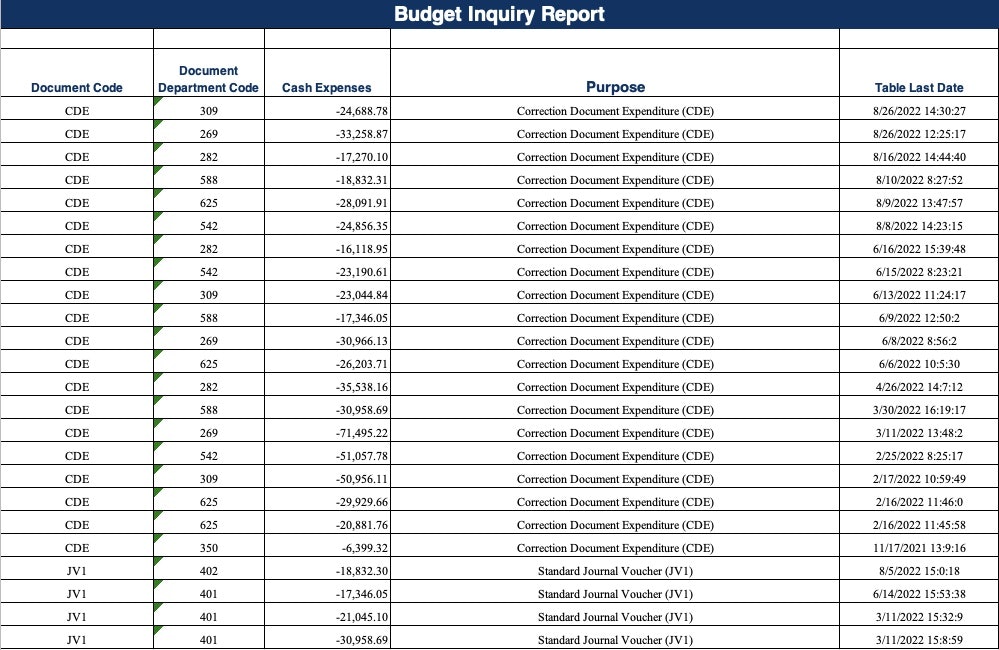
Van Rees said one transaction on the table “is not MOU related, but in order to be transparent, it is included.” That stemmed from time in August and September 2021 that Reynolds staffer Joel Anderson served as interim director of the Department of Management.
The transactions listed here add up to $669,267.45 in funds to support governor’s staff salaries during FY22. When you cross-check the agency numbers with the terms of the salary-sharing agreements, it breaks down this way:
- $135,720.22 from the Economic Development Authority (number 269, for Heather Nahas and Damian Bell)
- $68,927.21 from the Department of Education (number 282, for Molly Severn)
- $98,689.73 from Iowa Workforce Development (309, for Nate Ristow)
- $6,399.32 from the governor’s office (350—I suspect this was the payment not stemming from a salary-sharing agreement and is meant to be attributed to the Department of Management, number 532)
- $88,182.14 from the Department of Human Resources (401 and 402, for Traci Vitek and Clare Kelly)
- $99,104.74 from the Department of Natural Resources (542, for Jake Swanson)
- $67,137.05 from the Department of Public Health (588, for Clare Kelly)
- $105,107.04 from the Department of Revenue (625, for Patrick Tomka and Joel Anderson)
Don’t ask me how these transactions were executed without the governor’s office issuing any invoices.
Van Rees did not respond to my efforts to clarify some confusing aspects of this spreadsheet. What is the difference between “Standard Journal Voucher” and “Correction Document Expenditure” in this context? Why did one expense of $18,832.30 come out of the Human Services “Community Services” pot of money (402), rather than the regular Human Services budget (401)? Why is one $6,399.32 transaction coded as coming from the governor’s office itself (350)?
THE BOTTOM LINE
Given the shortcomings of the records provided and state employees’ refusal to answer follow-up questions, I can’t confirm exactly how much the governor’s office spent beyond its $2.3 million general fund appropriation during FY2022.
At minimum, other state agencies provided $784,000: just under $670,000 through accounting transactions to cover employee expenses, and just under $115,000 through assessments to the Office of State-Federal Relations that weren’t needed to pay for that office’s operations. The DOM paid an unknown amount for graphic design, and it’s not clear whether other non-salary costs were shifted elsewhere.
If the Republican-controlled legislature had any interest in exercising its oversight power, lawmakers might demand more information before writing Reynolds a blank check for $500,000. They might look into how the governor has been managing her budget, how much her office spending has increased in recent years, and how Reynolds’ staff misled them the last time GOP lawmakers agreed to a big funding boost.
They might ask why state agencies should continue to be billed for a two-person Office of State-Federal Relations when Reynolds has not attempted to fully staff that office for five years running.
But the story of the 2023 legislative session is House and Senate Republicans rubber-stamping almost everything the governor wants. So before lawmakers adjourn for the year, count on the majority party to give Reynolds a massive budget increase, “no questions answered.”
UPDATE: When the Iowa House debated this bill on May 2, Democratic State Representative Megan Srinivas criticized the “completely irresponsible” budget hike for the governor’s office. She noted that Republicans were going to approve the increase with no information about why the funds were needed or how they would be spent. In contrast, when applying for government grants in the medicine or public health fields, she and her colleagues spell out in great detail how the funds will be used, down to $15 beakers and pipettes.
During his closing remarks in support of Senate File 557, Republican State Representative Michael Bergan read out a statement provided by the governor’s office. He asserted the increase will help “recruit and retain the talented staff necessary to support the significant, whole of government work that Iowans expect the governor to lead.”
Top photo: Governor Kim Reynolds’ chief of staff Taryn Frideres (right) and Iowa Department of Management Director Kraig Paulsen appear before an Iowa House budget subcommittee on February 20, 2023. Photo by Laura Belin.

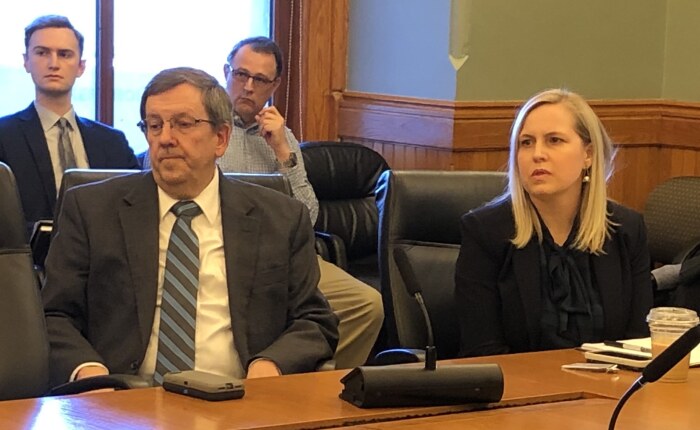
2 Comments
State Auditor
And now we know one reason why the State Auditor is being limited in what he can audit.
muskrat Mon 1 May 1:14 PM
Where is Chuck Grassley, when we need him
Sen. Grassley was once quoted for questioning spending on toilet seat covers. What Would Chuck Do if an elected official blew off his questions or an appointed official did not know about this level of spending. Maybe, the $500,000 is to install gender neutral bathrooms in the Gov.’s offices.
BTW–$500,000 is approximately the equivalent of $325, 000,000 at the federal budget level.
iowaralph Tue 2 May 8:53 PM